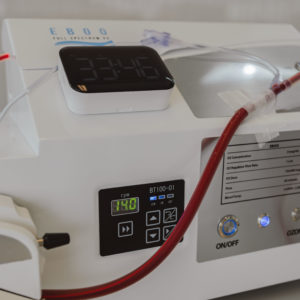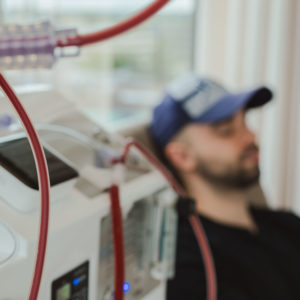4 min|Integrative
Empowering Your Gut: The Role of Motility in Digestive Wellness
Wellness, Health, Gut HealthUnderstanding Gut Motility
In a well-functioning digestive tract, there are three movement patterns to ensure food is digested and propelled through the gut, and the gut is cleared of food and bacteria once digestion is complete. These patterns, known as segmentation contraction, peristalsis, and the migrating motor complex (MMC), decrease the potential for small intestinal bacterial overgrowth by ensuring that food particles and bacteria are moved through the digestive tract, rather than accumulating in the small intestine. However, if there is dysfunction within any of these mechanisms, or imbalances within the digestive hormones that control them, gut motility is reduced, increasing the likelihood of SIBO (1).
Typically, when food is present, contractions and relaxations occur at intervals along the intestine; this process is known as segmentation contraction. These contractions and relaxations occur bidirectionally helping to mix partially digested food, known as chyme, with digestive enzymes. A small amount of propulsion occurs from this movement, contributing to movement of chyme toward the large intestine. Pacemaker cells, known as the cells of Cajal, initiate these contractions and set the pace and frequency. The nervous system of the gut, known as the enteric nervous system, as well as excitatory hormones (chemical messengers) must communicate with the cells of Cajal in order for the segmentation contractions to occur.
Peristalsis, a type of propulsive electrical movement, is primarily responsible for the movement of chyme through the small intestine to the large intestine. This process is slow, generally taking 3-5 hours to move chyme from the beginning of the small intestine to the ileocecal valve, where it will enter the large intestine.
The migrating motor complex (MMC) is a pattern of gut contraction that creates movement through the gut when it is empty. Regulation of the MMC is complex, requiring the release of many hormones and neurotransmitters, as well as activity of the enteric and autonomic nervous system (2). This contraction moves through the stomach and small intestine, towards the ileocecal valve. These waves occur in cycles, playing a housekeeping role, clearing the small intestine of remnants of food left behind during peristalsis and segmentation contraction, as well as bacteria (3). A small amount of bile and enzymes are released with each MMC. It is this ’sweeping’ of your small intestine that is responsible for the rumbling we feel between meals!
If there is dysfunction within any of these movement patterns, gut motility may be decreased, leading to constipation, changes in the gut microbiome, pain, and other digestive symptoms. Particularly, a decrease in Phase III activity of the MMC, the most active phase of its four phases, has been shown to be absent in cases of IBS and SIBO (2). Additionally, conditions that affect motility predispose toward development of SIBO.
What Causes Reduced Gut Motility? (2,4)
- Adhesions (scar tissue) resulting from surgery, infection, inflammation or trauma
- Chronic Intestinal Pseudo-obstruction (CIP), a digestive motility disease that generally affects the small intestine
- Colonic Inertia, a motility disease that generally affects the large intestine
- Achalasia, a digestive motility disease that affects the esophagus
- Blockages
- Dysmotility (weak or unsynchronized muscle contractions) due to Parkinson's disease, systemic sclerosis, injury to the nerves of the spinal cord
- Gastroparesis - a delay in the stomach emptying its contents into the intestine - usually caused by Diabetes, surgery
- Certain medications such as anticholinergics and opioid analgesics
- Stress
- MMC dysfunction
- Vagal nerve dysfunction
A significant amount of patients with SIBO have motility issues, particularly decreased MMC activity(3,5). While motility issues predispose patients to bacterial overgrowth, once overgrowth occurs, the methane gas that is produced in certain cases of SIBO (What is SIBO?) further slows the activity of the gastrointestinal tract(6). In turn, treating dysbiosis has an effect on dysmotility(7). It is essential to treat the dysmotility that contributed to development of SIBO, while also treating the bacterial overgrowth.
How Can We Improve Gut Motility?
Depending on the root cause of decreased gut motility, treatments vary greatly. For example, in cases of intestinal blockage, patients may have to undergo surgery to remove the blockage.
However, if gut motility is decreased due to dysfunction within any of the digestive movement patterns, certain substances and lifestyle habits that increase and coordinate intestinal motility may be helpful.
Examples of Substances to Affect Motility
- Natural cholinergic support, such as phosphatidylcholine, huperzine A(8), acetyl-L-carnitine, pantothenic acid
- Serotonin support: 5-HTP (9,10)
- Ginger (11)
- Melatonin (12)
- Low dose naltrexone (13)
- Low dose erythromycin (14)
Examples of Lifestyle Changes to Affect Motility
- Spacing meals apart, short-term fasting: both support activity of the MMC (15)
- Stress management (16)
- Slow, mindful eating
- Manual physical therapy such as visceral massage (7)
- Exercise
Book a consultation with one of our experienced Naturopathic Doctors today!
REFERENCES
- https://digitalrepository.aurorahealthcare.org/cgi/viewcontent.cgi?referer=https://www.google.ca/&httpsredir=1&article=1209&context=jpcrr
- https://digitalrepository.aurorahealthcare.org/cgi/viewcontent.cgi?referer=https://www.google.ca/&httpsredir=1&article=1209&context=jpcrr
- Pimentel M. A. New IBS Solution. Sherman Oaks, CA: Health Point Press; 2006.
- Whitehead WE. Gastrointestinal Motility Disorders of the Small Intestine, Large Intestine, Rectum, and Pelvic Floor. IFFGD Fact Sheet No. 162; 2001.
- http://www.tandfonline.com/doi/abs/10.3109/00365529609051995
- https://www.ncbi.nlm.nih.gov/pmc/articles/PMC3895606/
- https://www.ncbi.nlm.nih.gov/pubmed/12498278
- https://www.ncbi.nlm.nih.gov/pmc/articles/PMC3570168/
- https://www.ncbi.nlm.nih.gov/pmc/articles/PMC2694720/
- https://www.ncbi.nlm.nih.gov/pmc/articles/PMC1374798/
- https://www.ncbi.nlm.nih.gov/pmc/articles/PMC3016669/
- https://www.ncbi.nlm.nih.gov/pmc/articles/PMC3198018/
- https://www.ncbi.nlm.nih.gov/pubmed/23965429
- https://www.ncbi.nlm.nih.gov/pmc/articles/PMC1422092/
- http://ndnr.com/gastrointestinal/sibo/
- http://jpp.krakow.pl/journal/archive/12_11/pdf/591_12_11_article.pdf
- https://www.ncbi.nlm.nih.gov/pmc/articles/PMC4775771/
Related Articles

4 min|Dr. Alex Chan
EBOO for Chronic Inflammation: A Natural Approach for Systemic Relief
Regenerative Medicine, EBOO Therapy
4 min|Dr. Alex Chan
EBOO Therapy for Autoimmune Conditions: Exploring the Potential Benefits
Autoimmune Disease, Regenerative Medicine, EBOO Therapy


